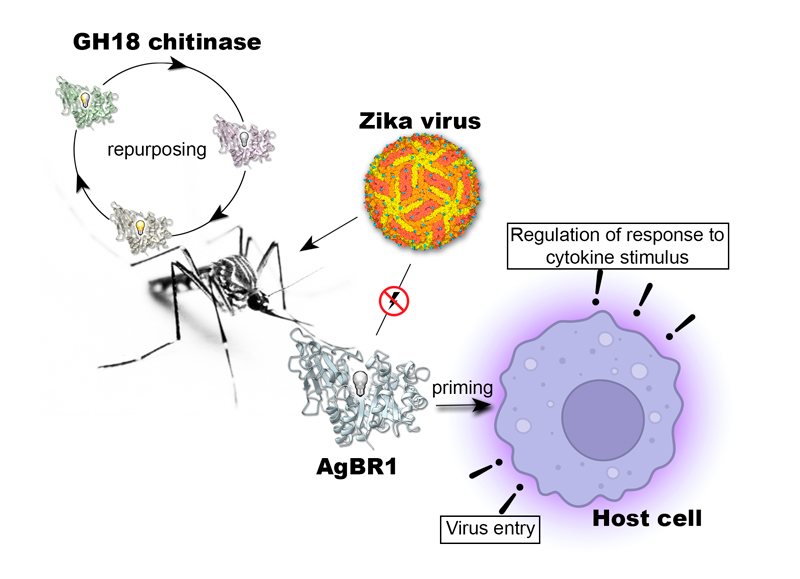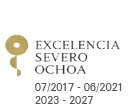
2025/04/28
New study reveals the structural and functional role of a mosquito salivary protein in the spread of the Zika virus
New research study, published in the Journal of Virology, has resolved the crystal structure of a key protein found in the saliva of the Aedes aegypti mosquito.
The research, led by a multidisciplinary team from CIC bioGUNE, reveals how this protein modulates the host's immune response during Zika virus infection.
These findings could open new pathways for the development of antiviral strategies.
A multidisciplinary research team from CIC bioGUNE, member of BRTA, has discovered how certain proteins in the saliva of the Aedes aegypti mosquito, the primary vector responsible for the transmission of human-infecting Zika virus, and other biomedically relevant flaviviruses such as dengue, yellow fever and chikungunya viruses, modulate the course of infection.
The study, published in Journal of Virology, provides new insights into how this protein influences the host’s immune response during Zika virus infection, offering potential pathways for the development of innovative antiviral strategies targeting mosquito-human interactions.
The research focuses on two salivary proteins, AgBR1 and NeSt1, which, when introduced into the human body during a mosquito bite, cause significant alterations in immune system cells. A major outcome of this research was the experimental determination of the three-dimensional structure of AgBR1 with exceptional detail by X-ray crystallography.
While AgBR1 shares structural similarities with chitinases, it was found to lack the sugar-degrading activity commonly associated with this family of proteins. This suggests that AgBR1 has undergone evolutionary repurposing to modulate the immune response instead.
While neither AgBR1 nor NeSt1 directly interact with the Zika virus or influence its replication, the study demonstrated that these proteins affect key immune processes, such as the activation of neutrophils and the production of inflammatory molecules. These findings suggest that AgBR1 and NeSt1 may facilitate the spread of the virus by altering the host’s immune environment, thereby promoting viral transmission.
This work not only provides an unprecedented description of the structure of one of the salivary proteins but also offers new information about how viruses like Zika can benefit from mosquito components to more easily infect humans.
“These findings, through the integration of structural, proteomics, and virus–host interaction studies, provide a comprehensive view of the complex interplay between mosquito salivary proteins and viral opportunism in modulating Zika virus infection,” explains Nicola GA Abrescia, Ikerbasque Research Professor and leader of the Virus Structure and Cellular Biology group.
This study represents a significant step forward in understanding the molecular interactions between disease vectors and the human immune system, demonstrating how structural and functional research can converge to address global public health challenges.
Reference: Ane Martínez-Castillo, Diego Barriales, Mikel Azkargorta, Juan Diego Zalamea, Ana Ardá, Jesús Jiménez-Barbero, Monika González-López, Ana M. Aransay, Alejandro Marín-López, Erol Fikrig, Félix Elortza, Juan Anguita, Nicola G. A. Abrescia. The structural and functional significance of Aedes aegypti AgBR1 flavivirus immunomodulator. Journal of Virology. DOI: 10.1128/jvi.01878-24.
About CIC bioGUNE
The Centre for Cooperative Research in Biosciences (CIC bioGUNE), member of the Basque Research & Technology Alliance (BRTA), located in the Bizkaia Technology Park, is a biomedical research organization conducting cutting-edge research at the interface between structural, chemical, molecular and cell biology, with a particular focus on generating knowledge on the molecular bases of disease, for use in the development of new diagnostic methods and advanced therapies.
About Ikerbasque
Ikerbasque - Basque Foundation for Science - is the result of an initiative of the Department of Education of the Basque Government that aims to reinforce the commitment to scientific research by attracting, recovering and consolidating excellent researchers from all over the world. Currently, it is a consolidated organization that has over 350 researchers/s, who develop their work in all fields of knowledge.
About BRTA
BRTA is an alliance of 4 collaborative research centres (CIC bioGUNE, CIC nanoGUNE, CIC biomaGUNE y CIC energiGUNE) and 13 technology centres (Azterlan, Azti, Ceit, Cidetec, Gaiker, Ideko, Ikerlan, Leartiker, Lortek, Neiker, Tecnalia, Tekniker y Vicomtech) with the main objective of developing advanced technological solutions for the Basque corporate fabric.
With the support of the Basque Government, the SPRI Group and the Provincial Councils of the three territories, the alliance seeks to promote collaboration between the research centres, strengthen the conditions to generate and transfer knowledge to companies, contributing to their competitiveness and outspreading the Basque scientific-technological capacity abroad.
BRTA has a workforce of over 4,000 professionals, executes 22% of the Basque Country's R&D investment, registers an annual turnover of more than 300 million euros and generates 100 European and international patents per year.
See a large version of the first picture





